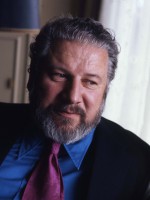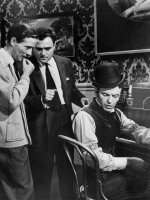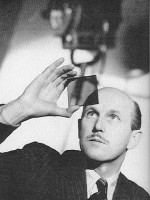Godfrey Tearle is a Actor American born on 12 october 1884 at New York City (USA)

Sir Godfrey Seymour Tearle (12 October 1884 – 9 June 1953) was a British actor who portrayed the quintessential British gentleman on stage and in both British and US films.
In 1893, he made his stage debut as young Prince Richard, Duke of York, in his father's production of Richard III, and in 1908 he appeared in his first film as Romeo in Romeo and Juliet. He became a Shakespearean actor of note, appearing on stage in the title roles of Othello, Macbeth, and Henry V. His theatrical career was interrupted when he joined the Royal Artillery for a four-year stint beginning in 1915.
One of Tearle's most memorable screen roles was in Alfred Hitchcock's The 39 Steps (1935), in which he portrayed Professor Jordan, a seemingly respectable country squire whose missing finger unmasks him as an enemy agent. He was cast as an RAF gunner in One of Our Aircraft Is Missing (1942), a German General in Undercover (film) (1943), an aging World War I veteran in Medal for the General (1944), and as Franklin D. Roosevelt in The Beginning or the End, MGM's 1946 account of the Manhattan Project.
Tearle made his Broadway theatre debut in Carnival in 1919. In his review in The New York Times, Alexander Woollcott noted, "It is difficult to guess why Godfrey Tearle should have selected as the vehicle of his American debut the play called Carnival, which was presented to New York for the first time last evening at the 44th Street Theatre. It is a spare and unsubstantial piece at best, and the role it offers him is distinctly secondary in importance and opportunity." Additional Broadway credits include The Fake (1924), The Flashing Stream (1939), and Antony and Cleopatra (1947).
Source : Wikidata
Godfrey Tearle

Birth name Godfrey Seymour Tearle
Nationality USA
Birth 12 october 1884 at New York City (USA)
Death 8 june 1953 (at 68 years) at London (United-kingdom)
Nationality USA
Birth 12 october 1884 at New York City (USA)
Death 8 june 1953 (at 68 years) at London (United-kingdom)
Biography
Born in New York City and brought up in Britain, he was the son of British actor/manager George Osmond Tearle (1852–1901) and American actress Marianne "Minnie" Conway(1852-1896), the brother of actor Malcolm Tearle, and the half-brother of silent film star Conway Tearle. His maternal grandmother was Sarah Crocker Conway.In 1893, he made his stage debut as young Prince Richard, Duke of York, in his father's production of Richard III, and in 1908 he appeared in his first film as Romeo in Romeo and Juliet. He became a Shakespearean actor of note, appearing on stage in the title roles of Othello, Macbeth, and Henry V. His theatrical career was interrupted when he joined the Royal Artillery for a four-year stint beginning in 1915.
One of Tearle's most memorable screen roles was in Alfred Hitchcock's The 39 Steps (1935), in which he portrayed Professor Jordan, a seemingly respectable country squire whose missing finger unmasks him as an enemy agent. He was cast as an RAF gunner in One of Our Aircraft Is Missing (1942), a German General in Undercover (film) (1943), an aging World War I veteran in Medal for the General (1944), and as Franklin D. Roosevelt in The Beginning or the End, MGM's 1946 account of the Manhattan Project.
Tearle made his Broadway theatre debut in Carnival in 1919. In his review in The New York Times, Alexander Woollcott noted, "It is difficult to guess why Godfrey Tearle should have selected as the vehicle of his American debut the play called Carnival, which was presented to New York for the first time last evening at the 44th Street Theatre. It is a spare and unsubstantial piece at best, and the role it offers him is distinctly secondary in importance and opportunity." Additional Broadway credits include The Fake (1924), The Flashing Stream (1939), and Antony and Cleopatra (1947).
Usually with
Filmography of Godfrey Tearle (29 films)
Actor
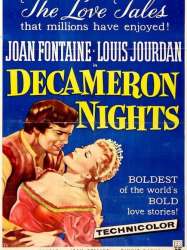
Decameron Nights (1953)
, 1h34Directed by Hugo Fregonese
Origin United-kingdom
Genres Adventure
Actors Joan Fontaine, Louis Jourdan, Godfrey Tearle, Joan Collins, Binnie Barnes, Meinhart Maur
Roles Ricciardo / Bernabo
Rating52%





In the mid-fourteenth century, Boccaccio seeks his true love, the recently widowed Fiametta (Joan Fontaine), and finds that she has fled Florence, plague-ridden and being sacked by an invading army, for a villa in the countryside with several female companions. When he shows up on her doorstep, Fiametta does not want to invite him to stay, but her friends, bored and lacking male companionship, override her objections. To entertain the ladies (and further his courtship of Fiametta), Boccaccio tells stories of the pursuit of love.

The Titfield Thunderbolt (1953)
, 1h24Directed by Charles Crichton
Origin United-kingdom
Genres Comedy
Themes Transport films, Rail transport films
Actors Stanley Holloway, George Relph, Naunton Wayne, John Gregson, Hugh Griffith, Godfrey Tearle
Roles Ollie Matthews (The Bishop)
Rating69%





The residents of the (fictional) rural village of Titfield rely on the railway branch line to commute to work and transport their produce to market. So they are shocked when the government announces that the line is to be closed. Particularly hard hit is the local vicar, railway enthusiast Rev. Sam Weech (George Relph); he comes up with the idea to run it locally. He and the local squire, Gordon Chesterford (John Gregson), persuade wealthy Walter Valentine (Stanley Holloway) to provide the financial backing by telling him they can legally operate a bar while the train is running, so he will not have to wait all morning for the local pub to open.
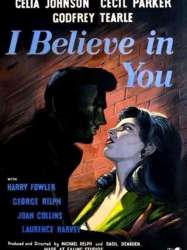
I Believe in You (1952)
, 1h35Directed by Basil Dearden, Michael Leighton George Relph
Origin United-kingdom
Genres Drama
Themes Prison films
Actors Celia Johnson, Cecil Parker, Alastair Sim, Godfrey Tearle, Harry Fowler, George Relph
Roles Judge Pyke
Rating67%





Henry Phipps a retired Colonial Serviceman takes on the job of a probation officer, and finds it a challenge. Various characters lives are examined as Phipps and his colleagues attempt to reform (amongst others), a hardened criminal and a juvenile delinquent.
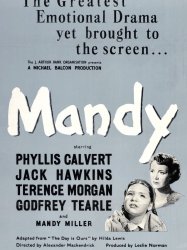
Mandy (1952)
, 1h33Directed by Alexander Mackendrick, Jim O'Connolly
Origin United-kingdom
Genres Drama
Themes Films about disabilities
Actors Phyllis Calvert, Jack Hawkins, Mandy Miller, Terence Morgan, Godfrey Tearle, Nancy Price
Roles Mr Garland senior
Rating73%





Harry and Christine Garland have a deaf daughter, Mandy. As they realise their daughter's situation, the parents enrol Mandy in special education classes to try to get her to speak. They quarrel in the process and their marriage comes under strain. There are also hints of a possible affair between Christine and Dick Searle, the headmaster of the school for the deaf where Mandy is enrolled. Eventually, the training succeeds to the point where Mandy says her own name for the first time. Mandy's speech was achieved by using a balloon. She was able to feel the vibrations of sound onto the balloon and knew she had made a sound.
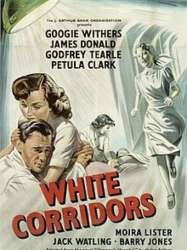
White Corridors (1951)
, 1h42Directed by Pat Jackson
Origin United-kingdom
Themes Medical-themed films
Actors Googie Withers, James Donald, Godfrey Tearle, Petula Clark, Jean Anderson, Timothy Bateson
Roles Mr. Groom Sr.
Rating69%





The day-to-day life of the staff and patients at a city hospital.
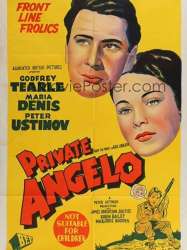
Private Angelo (1949)
, 1h46Directed by Peter Ustinov, Michael Anderson
Origin United-kingdom
Genres War, Comedy
Themes Political films
Actors Peter Ustinov, Godfrey Tearle, María Denis, Marjorie Rhodes, James Robertson Justice, Moyna MacGill
Roles Count Piccologrando
Rating73%





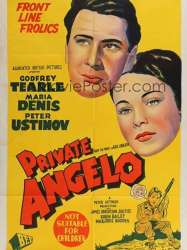
Private Angelo (1949)
, 1h46Directed by Peter Ustinov, Michael Anderson
Origin United-kingdom
Genres War, Comedy
Actors Godfrey Tearle, Peter Ustinov, María Denis, Marjorie Rhodes, James Robertson Justice, Moyna MacGill
Roles Count Piccologrando
Rating73%





Angelo est un soldat couard qui hérite d'un château en Italie. Il se retrouve involontairement impliqué dans la recherche du propriétaire du château par les Allemands, et même dans la marche sur Rome.
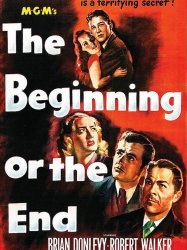
The Beginning or the End (1947)
, 1h52Directed by Norman Taurog
Origin USA
Genres Drama, War, Biography, Documentary, Historical
Themes Seafaring films, Transport films, Aviation films, Political films, Arme nucléaire
Actors Brian Donlevy, Hume Cronyn, Robert Walker, Audrey Totter, Tom Drake, Hurd Hatfield
Roles President Franklin D. Roosevelt
Rating65%





In 1945, physicist and atomic scientist Dr. J. Robert Oppenheimer (Hume Cronyn) praises the discovery of atomic energy, but also warns of its dangers. American scientists such as Matt Cochran (Tom Drake), working under the guidance of Dr. Enrico Fermi (Joseph Calleia) and Dr. Marré (Victor Francen), have split the atom, and essentially beaten the Germans in the race to create an atomic bomb. With the assistance of Albert Einstein (Ludwig Stössel), they inform President Franklin D. Roosevelt (Godfrey Tearle) that a monumental discovery has been made.

The Rake's Progress (1945)
, 2hDirected by Sidney Gilliat
Origin United-kingdom
Genres Drama, Comedy, Comedy-drama
Actors Rex Harrison, Lilli Palmer, Godfrey Tearle, Griffith Jones, Margaret Johnston, Guy Middleton
Roles Colonel Robert Kenway
Rating65%





The plot follows the career of upper-class cad Vivian Kenway (Rex Harrison). He is sent down from Oxford University for placing a chamber pot on the Martyrs' Memorial. Sent to South America, he rebels against plantation life, eventually becoming a car racing driver. He descends to a life of woman-chasing and drunkenness, which causes the death of his father, Colonel Kenway (Godfrey Tearle). The plot diverges from the theme of the Rake's Progress paintings by having him redeem himself by a hero's death in World War II.
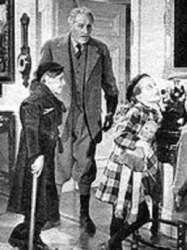
Medal for the General (1944)
, 1h40Directed by Maurice Elvey
Origin United-kingdom
Genres Drama, War
Themes Political films
Actors Godfrey Tearle, Petula Clark, Morland Graham, Mabel Constanduros, John Laurie, Patric Curwen
Roles General Church
Rating66%





The title character is Victor Church, a World War I veteran who becomes despondent when his advancing age prevents him from playing an active role in the battles of World War II. Feeling unwanted and useless, he retreats to his country estate and plans his suicide. He finds a new purpose in life when he opens his home to six rambunctious Cockney children evacuated from the London slums and tries to keep the mischievous group under control.
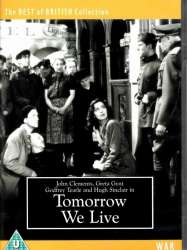
Tomorrow We Live (1943)
, 1h27Directed by George King
Origin United-kingdom
Genres Drama, War
Themes Political films
Actors John Clements, Godfrey Tearle, Greta Gynt, Hugh Sinclair, Yvonne Arnaud, Karel Štěpánek
Roles Mayor Pierre DuSchen
Rating62%





A young French idealist (John Clements), who gives his name as Jean Baptiste, arrives in "St Pierre-le-Port", a small town near Saint-Nazaire, a major port and base of operations for the German Navy, particularly their U-boats, on the Atlantic coast. Baptiste tells a member of the French Resistance that "I come from Saint-Nazaire. I've details of the submarine base, the docks and power plant. If I can get them to England..."

Undercover (1943)
, 1h20Origin United-kingdom
Genres Drama, War
Themes Political films
Actors John Clements, Mary Morris, Tom Walls, Stanley Baker, Michael Wilding, Godfrey Tearle
Roles General von Staengel
Rating60%





The film is based on the Yugoslav resistance movement under the command of General Draza Mihailovich. But politics overtook the situation because Mihailovich and the Royalists were about to be abandoned and betrayed by the British government - as parts of the Chetnik movement co-operated with the Nazis - in favor of the Communist and Stalinist leader Josip Broz Tito at the time. Speaking in the British Parliament on February 22, 1944, the then Prime Minister, Winston Churchill, said: “General Mihailovic, I much regret to say, drifted gradually into position where his commanders made accommodations with Italian and German troops…”

The Lamp Still Burns (1943)
, 1h27Directed by Maurice Elvey
Origin United-kingdom
Genres Drama, War, Documentary, Romance
Themes Political films
Actors Rosamund John, Stewart Granger, Godfrey Tearle, Cathleen Nesbitt, Margaret Vyner, John Laurie
Roles Sir Marshall Freyne
Rating61%





During the Second World War, Laurence Rains (Stewart Granger) is annoyed when female architect Hilary Clarke (Rosamund John) insists he must enlarge the first aid room in his factory to satisfy government regulations, despite having the best safety record in the country. He encounters her once again, now a nurse trainee assisting a doctor treat one of his employees. He finds out that Clarke only became an architect to please her father, who had no sons to follow in his profession. When she saw how her young assistant at her firm, seriously injured in a traffic accident, was tended to by the nurses, she found her true vocation. Pamela Siddell (Margaret Vyner), a violinist and Rains' fiancee, sees his attraction to Clarke.
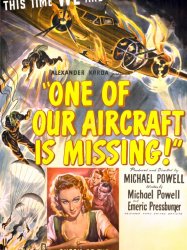 , 1h42
, 1h42Directed by Michael Powell, Emeric Pressburger
Origin United-kingdom
Genres Drama, War, Action
Themes Politique, Transport films, Aviation films, Documentary films about war, Documentary films about historical events, Political films, Documentary films about World War II, Disaster films, Films about aviation accidents or incidents
Actors Godfrey Tearle, Eric Portman, Hugh Williams, Bernard Miles, Hugh Burden, Emrys Jones
Roles Sir George Corbett, Rear Gunner in B for Bertie
Rating69%





"B for Bertie" is an RAF Vickers Wellington bomber whose crew was forced to bail out over the Netherlands near the Zuider Zee after one of their engines was damaged during a nighttime raid on Stuttgart. Five of the six airmen find each other; the sixth goes missing. The first Dutch citizens they encounter, led by English-speaking schoolteacher Else Meertens (Pamela Brown), are suspicious at first as no aircraft is reported to have crashed in the Netherlands (the abandoned bomber actually reaches England before hitting a pylon). After much debate and some questioning, the Dutch agree to help, despite their fear of German reprisals.

East Meets West (1936)
, 1h14Directed by Herbert Mason
Origin United-kingdom
Genres Drama, Romance
Actors George Arliss, Lucie Mannheim, Godfrey Tearle, Romney Brent, Ballard Berkeley, Ronald Ward
Roles Sir Henry Mallory
Rating60%





A small Middle Eastern state is coveted by the major powers for strategic reasons.
 Connection
Connection
